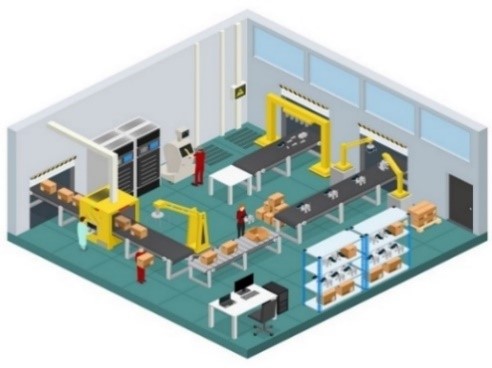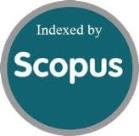Dynamic Processing 2D Maps Method for Robot’s Trajectory Planning
DOI:
https://doi.org/10.46604/peti.2024.14508Keywords:
image processing, map building, PRM, path planning, search algorithmAbstract
Unlike common usage of programmed maps, highly robust maps that mimic reality have rarely been tested for path-planning problems with a variety of search algorithms. Meanwhile, utilizing real-like maps might direct studies toward the image processing field and can be time-consuming. Therefore, this study aims to propose a method to effectively and quickly read and process 2D maps in such a way that search algorithms can recognize them. Simulations are conducted on two maps to show the merit of the proposed method. In all simulations, the proposed method successfully read and processed maps in an average time of 1.5043 seconds. Moreover, the search algorithm, which is a probabilistic roadmap can, quickly recognize the maps and plan feasible paths from starting points to target points.
References
R. Raj and A. Kos, “A Comprehensive Study of Mobile Robot: History, Developments, Applications, and Future Research Perspectives,” Applied Sciences, vol. 12, no. 14, article no. 6951, 2022.
J. Galarza-Falfan, E. E. García-Guerrero, O. A. Aguirre-Castro, O. R. López-Bonilla, U. J. Tamayo-Pérez, J. R. Cárdenas-Valdez, et al., “Path Planning for Autonomous Mobile Robot Using Intelligent Algorithms,” Technologies, vol. 12, no. 6, pp. 82–106, 2024.
B. Ciuffo, M. Makridis, V. Padovan, E. Benenati, K. Boriboonsomsin, M. T. Chembakasseril, et al., “Robotic Competitions to Design Future Transport Systems: The Case of JRC AUTOTRAC 2020,” Transportation Research Record, vol. 2677, no. 2, pp. 1165–1178, 2022.
R. Ranjan, S. Lee, and J. Kye, “Design of Tactical Multipurpose All–Terrain Mobile Robot,” International Journal of Membrane Science and Technology, vol. 10, no. 2, pp. 2224–2237, 2023.
P. Lin, C. Lin, C. Hung, J. Chen, and J. Liang, “The Autonomous Shopping-Guide Robot in Cashier-Less Convenience Stores,” Proceedings of Engineering and Technology Innovation, vol. 14, no. 2020, pp. 9–15, 2020.
M. Cognominal, K. Patronymic, and A. Wańkowicz, “Evolving Field of Autonomous Mobile Robotics: Technological Advances and Applications,” Fusion of Multidisciplinary Research, An International Journal, vol. 2, no. 2, pp. 189–200, 2021.
A. Garus, P. Christidis, A. Mourtzouchou, L. Duboz, and B. Ciuffo, “Unravelling the Last-Mile Conundrum: A Comparative Study of Autonomous Delivery Robots, Delivery Bicycles, and Light Commercial Vehicles in 14 Varied European Landscapes,” Sustainable Cities and Society, vol. 108, article no. 105490, 2024.
U. Sharma, U. S. Medasetti, T. Deemyad, M. Mashal, and V. Yadav, “Mobile Robot for Security Applications in Remotely Operated Advanced Reactors,” Applied Sciences, vol. 14, no. 6, article no. 2552, 2024.
M. N. A. Wahab, A. Nazir, A. Khalil, W. J. Ho, M. F. Akbar, M. H. M. Noor, et al., “Improved Genetic Algorithm for Mobile Robot Path Planning in Static Environments,” Expert Systems with Applications, vol. 249, article no. 123762, 2024.
L. D. Hanh and V. D. Cong, “Path Following and Avoiding Obstacle for Mobile Robot Under Dynamic Environments Using Reinforcement Learning,” Journal of Robotics and Control, vol. 4, no. 2, pp. 157–164, 2023.
I. A. Hassan, I. A. Abed, and W. A. Al-Hussaibi, “Path Planning and Trajectory Tracking Control for Two-Wheel Mobile Robot,” Journal of Robotics and Control, vol. 5, no. 1, pp. 1–15, 2024.
H. Qu, K. Xing, and T. Alexander, “An Improved Genetic Algorithm with Co-Evolutionary Strategy for Global Path Planning of Multiple Mobile Robots,” Neurocomputing, vol. 120, pp. 509–517, 2013.
K. Jose and D. K. Pratihar, “Task Allocation and Collision-Free Path Planning of Centralized Multi-Robots System for Industrial Plant Inspection Using Heuristic Methods,” Robotics and Autonomous Systems, vol. 80, no. C, pp. 34–42, 2016.
M. S. Das, S. Sanyal, and S. Mandal, “Navigation of Multiple Robots in Formative Manner in an Unknown Environment Using Artificial Potential Field Based Path Planning Algorithm,” Ain Shams Engineering Journal, vol. 13, no. 5, article no. 101675, 2022.
M. Dadgar, S. Jafari, and A. Hamzeh, “A PSO-Based Multi-Robot Cooperation Method for Target Searching in Unknown Environments,” Neurocomputing, vol. 177, pp. 62–74, 2016.
X. Ma, R. Gong, Y. Tan, H. Mei, and C. Li, “Path Planning of Mobile Robot Based on Improved PRM Based on Cubic Spline,” Wireless Communications and Mobile Computing, vol. 2022, article no. 1632698, 2022.
R. Sarkar, D. Barman, and N. Chowdhury, “Domain Knowledge Based Genetic Algorithms for Mobile Robot Path Planning Having Single and Multiple Targets,” Journal of King Saud University - Computer and Information Sciences, vol. 34, no. 7, pp. 4269–4283, 2022.
J. Leem, J. Choi, I. S. Kang, and J.-J. Song, “Optimal Camera Angle for Measuring Joint Roughness Using UAV-Based 3D Photogrammetry,” ARMA U.S. Rock Mechanics/Geomechanics Symposium, Colorudo,LISA, 2024.
X. Xu, Z. Yu, W.-Y. Chen, A. Chen, A. Motta, and X. Wang, “Automated Analysis of Grain Morphology in TEM Images Using Convolutional Neural Network with CHAC Algorithm,” Journal of Nuclear Materials, vol. 588, article no. 154813, 2024.
S. Bhutada, N. Yashwanth, P. Dheeraj, and K. Shekar, “Opening and Closing in Morphological Image Processing,” World Journal of Advanced Research and Reviews, vol. 14, no. 3, pp. 687–695, 2022.
B. Wang, Y. Jiang, Q. Zhang, H. Chen, and R. Liu, “Experimental Investigation on the Cyclic Shear Behavior of Intermittent Joints,” International Journal of Rock Mechanics and Mining Sciences, vol. 181, article no. 105854, 2024.
P. Panagos, F. Matthews, E. Patault, C. D. Michele, E. Quaranta, N. Bezak, et al., “Understanding the Cost of Soil Erosion: An Assessment of the Sediment Removal Costs from the Reservoirs of the European Union,” Journal of Cleaner Production, vol. 434, article no. 140183, 2024.
C. Zhengzheng, Y. Xiangqian, Z. Peiding, L. Zhenhua, D. Feng, W. Wenqiang, et al., “Experimental Study on the Fracture Surface Morphological Characteristics and Permeability Characteristics of Sandstones with Different Particle Sizes,” Energy Science & Engineering, vol. 12, no. 7, pp. 2798–2809, 2024.
X. Zang, Z. Qiu, H. Zhong, X. Zhao, P. Guo, W. Gao, et al., “Fracture Surface Morphology Characterization and Its Influence on Plugging Performance of Granular Lost Circulation Materials,” Geoenergy Science and Engineering, vol. 230, article no. 212189, 2023.
N. Liu, Z. Hu, M. Wei, P. Guo, S. Zhang, and A. Zhang, “Improved A* Algorithm Incorporating RRT* Thought: A path Planning Algorithm for AGV in Digitalised Workshops,” Computers & Operations Research vol. 177, article no. 106993, 2025.
S. Sabeeh and I. S. Al-furati, “Efficient Path Planning in Medical Environments: Integrating Genetic Algorithm Efficient Path Planning in Medical Environments: Integrating Genetic Algorithm and Probabilistic Roadmap (GA-PRM) for Autonomous Robotics,” Iraqi Journal for Electrical and Electronic Engineering, vol. 20, no. 2, pp. 243–258, 2024.
J. Ou, S. H. Hong, G. Song, and Y. Wang, “Hybrid Path Planning Based on Adaptive Visibility Graph Initialization and Edge Computing for Mobile Robots,” Engineering Applications of Artificial Intelligence, vol. 126, article no. 107110, 2023.
X. Zheng, J. Cao, B. Zhang, Y. Zhang, W. Chen, Y. Dai, et al., “Path Planning of PRM Based on Artificial Potential Field in Radiation Environments,” Annals of Nuclear Energy, vol. 208, article no. 110776, 2024.
J. Zhao, C. Deng, H. Yu, H. Fei, and D. Li, “Path Planning of Unmanned Vehicles Based on Adaptive Particle Swarm Optimization Algorithm,” Computer Communications, vol. 216, pp. 112–129, 2024.
A. Meysami, S. Kelouwani, J.C. Cuilliere, V. Francois, A. Amamou, and B. Allani, “An Efficient Indoor Large Map Global Path Planning for Robot Navigation,” Expert Systems with Applications, vol. 248, article no. 123388, 2024.

Published
How to Cite
Issue
Section
License
Copyright (c) 2025 Shaymaa Azubairi, Alexdener Petunin, Hussam Lefta Alwan, Mohammed Majid Msallam, Amjad J. Humaidi

This work is licensed under a Creative Commons Attribution-NonCommercial 4.0 International License.
Submission of a manuscript implies: that the work described has not been published before that it is not under consideration for publication elsewhere; that if and when the manuscript is accepted for publication. Authors can retain copyright of their article with no restrictions. Also, author can post the final, peer-reviewed manuscript version (postprint) to any repository or website.

Since Oct. 01, 2015, PETI will publish new articles with Creative Commons Attribution Non-Commercial License, under The Creative Commons Attribution Non-Commercial 4.0 International (CC BY-NC 4.0) License.
The Creative Commons Attribution Non-Commercial (CC-BY-NC) License permits use, distribution and reproduction in any medium, provided the original work is properly cited and is not used for commercial purposes







